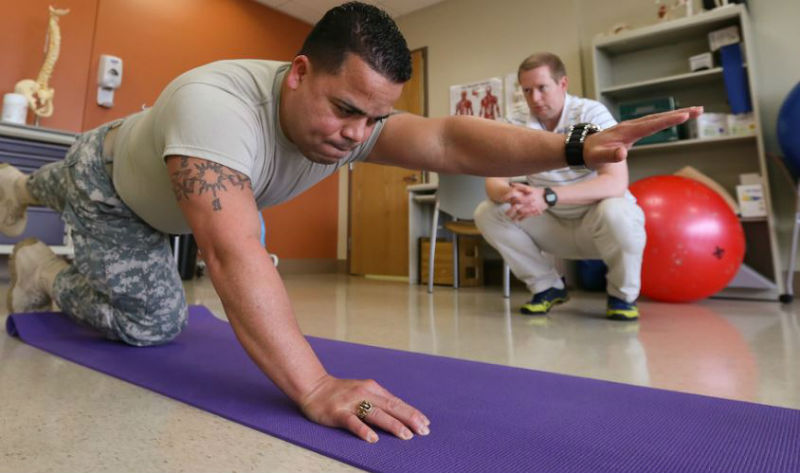
Choosing the proper sports hernia treatment can mean the difference between a successful recovery and lifelong pain.
While it is first important to receive a proper diagnosis to confirm that you have the injury over a much less-serious groin strain (sports hernia symptoms vs. groin pain symptoms).
Luckily, you can also diagnose yourself using the pubic probe method. After confirming the location of your sports hernia pain, it is time to move onto the treatment plan.
If you do have the injury, you are likely wondering if sports hernia treatment without surgery is possible. There are currently two documented cases of non-surgical intervention successfully relieving pain. One of the patients was a professional golfer and the other was a pro hockey player.
What factors likely contributed to their success without having surgery?
- Both patients were professional athletes with high activity levels—their general fitness no doubt contributed to their success
- Both patients received a prompt diagnosis—the common time between getting injured and narrowing it down to this specific injury is normally months, increasing the difficulty of successful non-surgical treatment dramatically
- Both patients followed a rehabilitation program focused on full restoration of core strength and function—far more than most traditional physical therapy approaches
- Both patients were required to do rehab—it was part of their job and they never missed sessions
If you have a high fitness level, receive a speedy diagnosis, and follow the full 10-week rehabilitation program without missing a single session—your chances are very high.
Even if you do fit that description, the longer you wait to begin treatment, the higher your chances of requiring surgery increase. If you do need to go under the knife, rest assured that surgery isn’t anything to be afraid of (as long as you get the minimal repair technique over mesh).
Get the ULTIMATE Sports Hernia Master Guide with 30+ included resources, an in-depth rehabilitation program, tips, tricks, and more! Successfully diagnose, treat, and cure your sports hernia with this complete master guide created by a sports hernia specialist. Note that it is still highly recommended to read this article in full to understand how to get the most out of the guide to treat and cure your sports hernia or groin pain.
Sports Hernia Treatment Plan
The sports hernia treatment plan is comprised of three distinct phases that combine to form a holistic rehabilitation program.
- Stretching
- Mobility
- Exercises
By incorporating all three, you regain strength, flexibility, and mobility in your core and restore balance to your injured musculoskeletal system.
Complete the following treatment circuit 2-5 times per week.
Sports Hernia Treatment: Stretching
The first step in the treatment plan is one you could probably guess: stretching.
They will provide initial pain relief and prepare you for the mobility section in part two.
When you are completing the stretches, make sure to do each one three times. Additionally, make sure you hold each stretch for 30-60 seconds before releasing tension.
It is recommended that you complete them in a circuit (view the sports hernia stretches guide for pictures and video examples):
- Seated Hip Internal Rotator Stretch
- Hip Flexor and Psoas Bench Stretch
- Standing Calf Stretch
- Table Hip Flexor and Psoas Stretch
- Seated Groin Stretch
- Frog Stretch
- Lying Quad Stretch
- Standing Hamstring Reach
Sports Hernia Treatment: Mobility
Along with stretching, mobility helps to re-engage your tight and inhibited muscles. The sedentary perils of modern day-to-day life can literally “turn off” your muscles if you fail to take corrective measures.
Whenever we sit for extended periods of time, drive a vehicle, carry a backpack, or perform any other number of activities in our daily life, we gradually build up tension. This tension can become large enough to eventually cause us to develop weird movement patterns and uneven muscles.
If you sit down at a computer desk for much of your work week, it’s almost a guarantee that your glutes are so inhibited you barely feel them contract. Over enough period of time, this lack of proper movement leads to pain and eventually a sports hernia given enough pressure.
There is good news, though.
Combating these issues is extremely simple with the use of a lower-body mobility routine. But as we already mentioned above—if you want real success you need to commit and make sure not to miss a planned physical therapy session.
Sports Hernia Treatment: Exercises
The final stage in the rehabilitation process includes exercises. This is the real bread and butter of what makes it successful.
The stretching and mobility steps are absolutely critical as part of the sports hernia treatment—they help prepare you for the final stage with is strengthening with exercises.
However, long-term relief from pain symptoms requires you to strengthen the weak and dis-engaged muscles that caused you to develop improper movement patterns and get injured in the first place.
There are a total of 9 exercises you should be doing (view the sports hernia treatment exercises guide for pictures and video examples):
- Hip Bridge
- Dog Legs
- Bent-Legged Side Levers
- Psoas Hold
- Adduction (against a ball)
- Ab Roll-outs
- Reaching One-Legged Deadlifts
- Abdominal Vacuums
- Bosu Ball Crunches
These movements only make up the first strengthening phase, however. Once you have completed them for a total of two weeks with zero pain, you are ready to move onto the second strengthening phase.
While getting this injury may seem like a life sentence to terrible groin pain, it’s not. By following the steps outlined above, you can relieve pain and finally rehabilitate your injury—for good.
